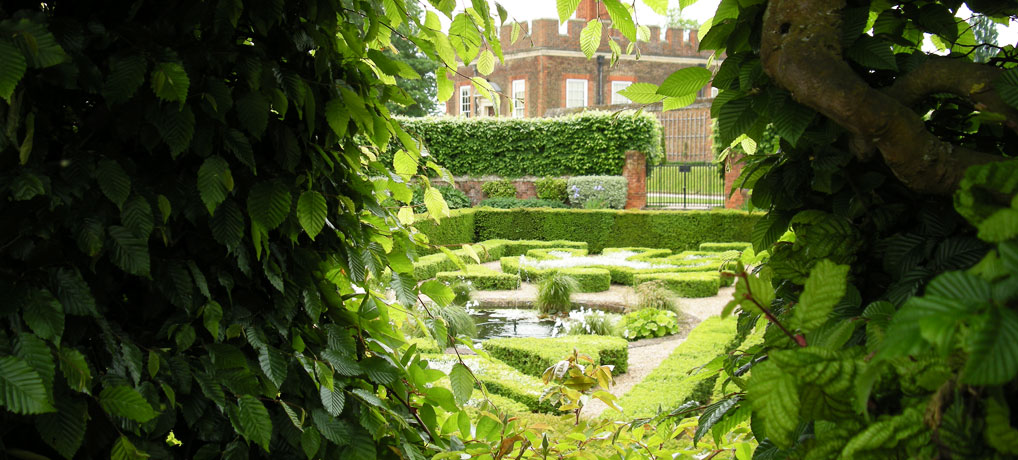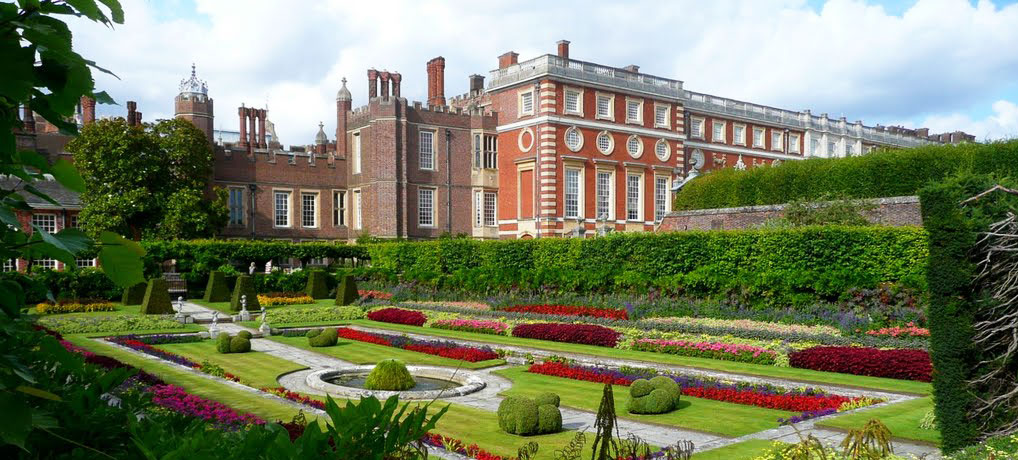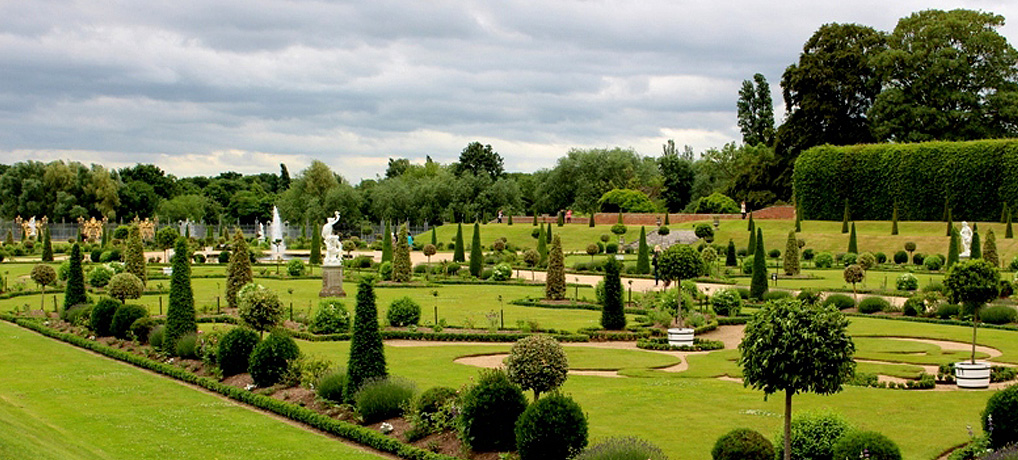Cardinal Wolsey
Conduits were laid in to bring water from Coombe Hill.

Henry VIII
At the time of his marriage to Anne Boleyn, and possibly under her influence with experience of more sophisticated Continental courts, the formal gardens were developed, stretching from the Palace to the river. The edges of the flowerbeds were delimited in the Tudor colours of green and white. There were six foot tall weather vanes formed from mythical heraldic beasts; Anne’s own “heraldic beast,” a leopard , was represented by coloured statues in the flowerbeds.
The King was particularly interested in his Tilting Ground at the North of the palace, where one of five original observation towers remains. Here were held the tournaments in an area of seven acres enclosed by high brick walls. The five towers gave the favoured spectators the best views of the jousting.
His Privy (private) Garden to the South of the palace was developed over eight years, 1530-1538, Henry had raised a mound crested with a gazebo from which he could look down on the River Thames. There was a collection of 16 brass sundials, statues of “heraldic” or emblematic beasts, a bowling alley, a domed banqueting house, and the Water Gallery which gave covered access to the River Thames. There was also a kitchen (vegetable) garden.
Queen Elizabeth
A “knot: garden was made, by which is meant literally a garden planted in the form of a knot, continuous interlacing bands, in an endless situation, akin to “∞” the sign for infinity.
Charles 1
In 1638 Charles directed a connection be made with the River Colne, at Longford, across Hounslow Heath and into the parks of Hampton Court, to supply the ponds, fountains and for drinking water. This required cutting a channel twenty-one feet wide, two feet deep, eleven miles long, effected in part by banking up an existing tributary of the river, the work becoming known as “The King’s Longford River.” (Coombe Hill water was discontinued 1876.)
The works on the Longford River also involved the building of sluices and floodgates, some of which caused annoyance to those living in the region.
Improvements to the gardens were ordered, statues were installed. In 1639 the King had the idea to make a Great Park between the palaces of Hampton Court and Richmond. There was much common land and private property involved in the zone contemplated, the King was advised against this plan which would cause great offence to the local habitants, but Charles insisted, he had “already caused brick to be burned” and he was going ahead with a walled enclosure. With difficulty, Archbishop Laud persuaded him against this forfeiture of citizens’ land.
Charles II
The works follow the patterns established by Claude Mollet for gardens in France such as the Tuilleries. Gardeners from France were brought in under the direction of Mr. May; the dwarf yew trees were famous. The Home Park was planted with avenues of lime trees which radiated out from the east front of the Palace, and a Long Canal stretched for three fourths of a mile to the river, the ensemble representing the three toed patte d’oie (goose foot) design of Mollet. Charles had admired this work in both France and Holland. More than five hundred lime trees were planted in an avenue along the canal, and these have since been restored. Charles had the parks restocked with game for hunting.
Duke Cosmo III who visited the palace in 1669 described the gardens, “divided into very large, level and well kept walks, which separating the ground into different compartments, form artificial patterns of grass, being themselves formed of espalier trees, partly such as bear fruit and partly ornamental ones, but all adding to the beauty of the appearance. This beauty is further augmented by fountains made of slate after the Italian style, and distributed in different parts of the garden, whose jets d’eaux throw up the water in various playful and fanciful ways. There are also in the gardens some snug places of retirement in certain towers, formerly intended as places of accommodation for the King’s mistresses.”

King William and Queen Mary
It should be understood that this devoted couple had a great deal of experience in designing formal gardens in Holland before they were ever confronted with having to go to England.
To William is attributed the Great Fountain Garden, designed with the aid of Daniel Marot, a French Huguenot who took refuge in the Netherlands; it is described as having long scrolls of broderie, edged with dwarf box, enriched with statues, pyramids of yew, globes of bay and holly and 13 fountains playing between the palace and a semi-circular canal (only one of these fountains has survived). The Chestnut Avenue leading to Bushey Park was designed by Wren and executed by Henry Wise.
William demolished four of the five towers in the Tilt Yard (since 1924 the remaining tower is now a visitors’ tea room) and the grounds were employed as a vegetable garden. He also flattened the mound and removed the gazebo Henry VIII had installed, and where Henry had an orchard, William replaced it with the Wilderness Garden a term that is easily misunderstood. “Wilderness” was the last thing it represented, and although “wild” is also used, it was in fact a highly structured and controlled part of a garden where the walker might seek his own spiritual origins, might dally with members of the opposite sex, might experience the sensation of being lost but knew he would always be found. Of course, Versailles was there first with the Jardin des Sources. William’s garden was planned by Christopher Wren and laid out by London and Wise; it was geometrical in design, with two principal alleys which intersected like a Saint Andrew’s cross – one of the initial four Mazes survives today, its paths are half a mile in length and it is all that remains of the original “wilderness.”
To Mary is attributed, also with the help of Marot, the Privy Garden and the “Glass Case” garden for protection of tender and exotic plant species; she chose the warmest part of the garden, a point which previously had been Henry VIII’s pond yard. She had collected species from around the world and these were put into the charge of Doctor Leonard Plukenet, Royal Professor of Botany and author of a four volume treatise on exotic plants. Construction was by Heindrik Floris who knew the greenhouses by the term, “stove houses.” The 12 wrought iron panels designed by Tijou were set up.
In wet weather the Queen enjoyed the use of the Water Gallery, created as a covered way for the benefit of royalty connecting the palace to the riverside landing place. In this passageway the Queen displayed her porcelain on pedestals carved by Grinling Gibbons. Lady Castlemaine (the maîtresse en titre manquée) had made a sort of play dairy there, perhaps attempting to emulate the Petit Treanon.
Later, after the death of Queen Mary, William had her master-gardener Henry Wise lower the Privy Garden by 10 feet so he had a better view of the Thames from his Orangery (history has not recorded the opinions of the workers!). He also demolished the Water Gallery, and Gibbons’ works were moved to different parts of the palace. The Great Terrace was built, running for a half mile along the Thames to a bowling green where are located the four pavilions designed by Wren. A Banqueting House was designed by Talman and built on the edge of the river, yet one more attempt to ape Versailles with an intended aviary and zoo. The Queen had three greenhouses for her exotic plants, these were replaced after her death by a single glasshouse, the Second or Lower Orangery, designed by Christopher Wren, which is the one currently surviving, and which was later employed as an art gallery.
A note on Orange and Orangery
Strange that the name of a piece of land, less than 100 hectares in the South of France should travel so far. It was a minor principality in the Holy Roman Empire ruled by the Prince of Orange; the Count of Nassau in the Netherlands acquired the property by inheritance, and assumed the title, which became Orange-Nassau. William III of England was the last reigning Prince of Orange, the land went to Louis XIV and the title to the King of Prussia. “Orange” was perpetuated wherever the Dutch went, including Ireland, South Africa and North America.
Although the “Orangery” in Hampton Court is associated with William of Orange, the term has a different history. Essentially it’s what we would now term a “greenhouse” or “conservatory.” The early purpose was to cultivate citrus trees in a climate that was not friendly the year round, so in Padua in 1545 they had fires to warm their trees, as one will find today in Florida. The Italians and the Dutch had experts who made glass coverings for their buildings. Oranges were grown in England by Sir Frances Carew in 1562, sheltered in winter by a “tabernacle of boards warmed by means of stoves.” In England when John Parkinson created his orangery in 1628 he protected the trees with waxed cloth, and in the middle of the 17th century orangeries of one form or another were very common in continental Europe for both showplaces and commerce. In the houses of the nobility they were also used as gathering places for social events, noticeably Versailles led in their design.

Queen Anne
Despite being substantially overweight and crippled by an affliction which might have been gout, Anne enjoyed following the hunt on the grounds of Hampton Court, driving her own two-wheel chaise, at a speed considered reckless. She seemed more interested in the exterior grounds than the interior furnishings of the palace. Avenues suitable for her chaise were cut through the parks, many of the fountains at the Great Fountain Garden were dismantled, new stretches of water were installed, hedges and trees were altered, and an overall more simple “English” design created from the highly styled “French” gardens.
Hanoverians
The grounds were maintained but not altered under George I. Queen Caroline, wife of George II had some of their elaborate nature reduced and flower beds were altered to form lawns. Under King George III, known to the people as “Farmer George,” his head gardener, “Capability” Brown, reduced the labour of upkeep by what euphemistically was called “naturalising.” Much of the labour and skill of intensive topiary was abandoned to free growth, thereby changing the appearance of the gardens from formal stylised French to casual and comfortable, if rather ragged, English.
